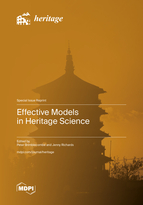Effective Models in Heritage Science
A special issue of Heritage (ISSN 2571-9408).
Deadline for manuscript submissions: closed (31 January 2023) | Viewed by 21625
Special Issue Editors
2. School of Environmental Sciences, University of East Anglia, Norwich NR4 7TJ, UK
Interests: air pollution exposure; air pollution in China; fireworks pollution; heritage climatology
Special Issues, Collections and Topics in MDPI journals
Special Issue Information
Dear Colleagues,
Although a range of models have been applied in heritage science, practical uptake and utilisation has often been limited. This Special Issue will present various heritage models designed to serve as input in practice.
Heritage sites and objects are shaped by their environment. Investigating interactions between heritage and its surroundings is vital for establishing processes of change and informing management decisions. Process-based models provide a tool for exploring the effect of environmental change. Such work should contribute to better practice in heritage science and practical conservation and optimally encourage a two-way exchange of understanding between research and practice. However, within the heritage field, modelling is not as commonly applied as might be expected.
In this Special Issue, we will present a range of process-based models applied to tangible heritage objects and sites that have substantial potential or implications for heritage practice. The contributions should illustrate how the gap between heritage science and practice can be successfully bridged.
Examples of potentially suitable models for consideration in this Special Issue include:
- Models examining dominant processes of change.
- New or refined models quantifying the deterioration process and potential strategies to minimise deterioration.
- Models addressing heritage lifespans.
- Process-based models that demonstrate a strong trajectory towards improving the practical use of outputs.
Models will likely be quantitative or semi-quantitative.
Prof. Dr. Peter Brimblecombe
Dr. Jenny Richards
Guest Editors
Manuscript Submission Information
Manuscripts should be submitted online at www.mdpi.com by registering and logging in to this website. Once you are registered, click here to go to the submission form. Manuscripts can be submitted until the deadline. All submissions that pass pre-check are peer-reviewed. Accepted papers will be published continuously in the journal (as soon as accepted) and will be listed together on the special issue website. Research articles, review articles as well as short communications are invited. For planned papers, a title and short abstract (about 100 words) can be sent to the Editorial Office for announcement on this website.
Submitted manuscripts should not have been published previously, nor be under consideration for publication elsewhere (except conference proceedings papers). All manuscripts are thoroughly refereed through a single-blind peer-review process. A guide for authors and other relevant information for submission of manuscripts is available on the Instructions for Authors page. Heritage is an international peer-reviewed open access monthly journal published by MDPI.
Please visit the Instructions for Authors page before submitting a manuscript. The Article Processing Charge (APC) for publication in this open access journal is 1600 CHF (Swiss Francs). Submitted papers should be well formatted and use good English. Authors may use MDPI's English editing service prior to publication or during author revisions.







